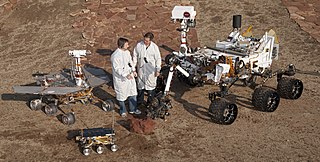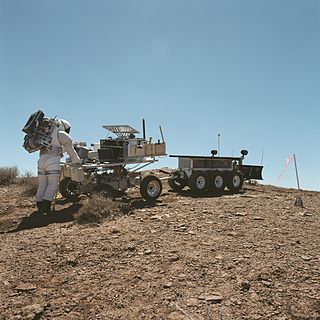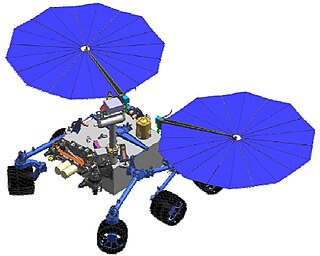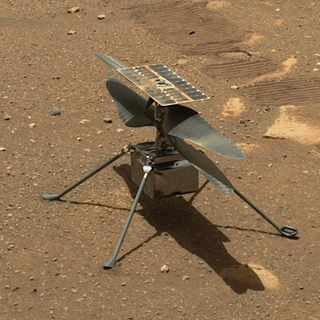An autonomous robot is a robot that acts without recourse to human control. The first autonomous robots environment were known as Elmer and Elsie, which were constructed in the late 1940s by W. Grey Walter. They were the first robots in history that were programmed to "think" the way biological brains do and meant to have free will. Elmer and Elsie were often labeled as tortoises because of how they were shaped and the manner in which they moved. They were capable of phototaxis which is the movement that occurs in response to light stimulus.

The Mars Desert Research Station (MDRS) is the largest and longest-running Mars surface research facility and is one of two simulated Mars analog habitats owned and operated by the Mars Society.
The Centennial Challenges are NASA space competition inducement prize contests for non-government-funded technological achievements by American teams.
Robotix is an annual robotics and programming event that is organised by the Technology Robotix Society at the Indian Institute of Technology Kharagpur. It is held during Kshitij, the institute's annual techno-management festival. Participation is open to college students. The event gives contestants an opportunity to showcase their talents in the fields of mechanical robotics, autonomous robotics and programming.
A space competition is an inducement prize contest offering a prize to be given to the first competitor who demonstrates a space vehicle, or a space exploration apparatus, which meets a set of pre-established criteria. It spurs pioneering development in private spaceflight.

A rover is a planetary surface exploration device designed to move over the rough surface of a planet or other planetary mass celestial bodies. Some rovers have been designed as land vehicles to transport members of a human spaceflight crew; others have been partially or fully autonomous robots. Rovers are typically created to land on another planet via a lander-style spacecraft, tasked to collect information about the terrain, and to take crust samples such as dust, soil, rocks, and even liquids. They are essential tools in space exploration.

NASA's Desert Research and Technology Studies is a group of teams which perform an annual series of field trials seeking to demonstrate and test candidate technologies and systems for human exploration of the surface of the Moon, Mars, or other rocky bodies.

The idea of sending humans to Mars has been the subject of aerospace engineering and scientific studies since the late 1940s as part of the broader exploration of Mars. Long-term proposals have included sending settlers and terraforming the planet. Proposals for human missions to Mars have come from agencies such as NASA, CNSA, the European Space Agency, Boeing, and SpaceX. Currently, only robotic landers and rovers have been on Mars. The farthest humans have been beyond Earth is the Moon, under the Apollo program.

Botball is an educational robotics program that focuses on engaging middle and high school aged students in team-oriented robotics competitions. Thousands of children and young adults participate in the Botball program. It has been active since 1998 and features a robotics curriculum which focuses on designing, building and programming a pair of autonomous robots. Teams use a standardized kit of materials, document the process and then compete in a tournament in which the challenges change annually. All materials in the kits are exactly the same for every team around the world, so there are no unfair advantages. Botball teams are mostly based in the United States with over 300 teams and local tournaments in more than a dozen regions. In recent years it also holds an annual Global Conference on Educational Robotics (GCER), with an international tournament that attracts teams all over the country as well as from Mexico, Austria, China, Uganda, Poland, Qatar, Kuwait, Egypt, and many others.

ATHLETE is a six-legged robotic lunar rover under development by the Jet Propulsion Laboratory (JPL). ATHLETE is a testbed for systems, and is designed for use on the Moon.

The Mars Astrobiology Explorer-Cacher (MAX-C), also known as Mars 2018 mission, was a NASA concept for a Mars rover mission, proposed to be launched in 2018 together with the European ExoMars rover. The MAX-C rover concept was cancelled in April 2011 due to budget cuts.
Mission Mars was the 2003-04 challenge theme of FIRST Lego League. It revolved around the NASA missions to Mars with the Spirit and Opportunity rovers.

The OSU Mars Rover is a student-organized project, which designs, builds, and tests a remotely operated terrestrial rover every year. The rover competes in the University Rover Challenge (URC), hosted by the Mars Society. The team is composed of students in Electrical Engineering, Mechanical Engineering, Software Engineering, and Science at Oregon State University.

Mars 2020 is a Mars rover mission that includes the rover Perseverance, the small robotic helicopter Ingenuity, and associated delivery systems, as part of NASA's Mars Exploration Program. Mars 2020 was launched from Earth on an Atlas V launch vehicle at 11:50:01 UTC on 30 July 2020, and confirmation of touch down in the Martian crater Jezero was received at 20:55 UTC on 18 February 2021. On 5 March 2021, NASA named the landing site of the rover Octavia E. Butler Landing. As of 2 January 2024, Perseverance and Ingenuity have been on Mars for 1020 sols.
The Faculty of Engineering at Monash University is one of the largest engineering faculties in Australia, with over 6,700 students in 2015.

European Rover Challenge is an annual Martian robot competition held in Poland. It began in 2014 at the at the Regional Science and Technology Centre in Chęciny and has been held at the Kielce University of Technology since 2019.

Ingenuity, nicknamed Ginny, is a small autonomous helicopter presently operating on the planet Mars. It is part of NASA's Mars 2020 mission. The helicopter arrived on the Martian surface attached to the underside of the Perseverance rover, which landed on February 18, 2021. The helicopter was deployed to the surface on April 3, 2021. Both the rover and the helicopter began their missions on Mars at the Octavia E. Butler Landing site near the western rim of the 28 mi (45 km) wide Jezero crater.

Rover Ruckus, officially known as Rover Ruckus Presented by Qualcomm for sponsorship reasons, is the FIRST Tech Challenge game for the 2018–2019 season. In the competition, two alliances of two teams each compete to collect minerals and place them into the cargo holes of the lander. Rover Ruckus is the fourteenth FTC game.

Swati Mohan is an Indian-American aerospace engineer and was the Guidance and Controls Operations Lead on the NASA Mars 2020 mission.

















